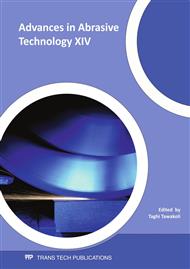p.19
p.28
p.35
p.42
p.48
p.54
p.60
p.66
p.72
Single Grain Scratch Tests to Determine Elastic and Plastic Material Behavior in Grinding
Abstract:
This paper presents an overview of kinematic simulations in grinding. Up to now the simulations are carried out under the assumption of an ideal cutting process. Therefore, the simulation results are not exactly identical to the experimental results. For this reason, the simulation needs to be enhanced with the plastic material flow during cutting. To explain this behavior, single grain scratch experiments were conducted to detect the different sources of influence on the plastic deformation and on the pile-up. First, in the experiments the grain shapes as well as the cutting speeds were varied. To take the effect of different grain shapes into account, three different grains were used. The effect of the cutting speed was investigated at cutting speeds ranging from 60 to 120 m/s. The results were evaluated with a confocal microscope. To quantify the results of the efficiency of the cutting process, the relative chip volume parameter was used.
Info:
Periodical:
Pages:
48-53
Citation:
Online since:
August 2011
Authors:
Keywords:
Price:
Сopyright:
© 2011 Trans Tech Publications Ltd. All Rights Reserved
Share:
Citation:


